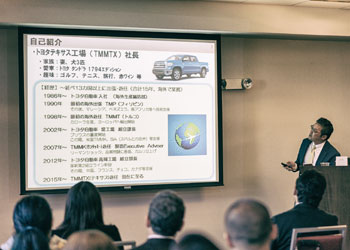

 Japanese Language Education Update
Japanese Language Education UpdateThe 2015 survey conducted by the Japan Foundation on the state of Japanese language education indicates a 9.7% increase in Japanese language learners in the United States (compared to 2012), however the number of Japanese teachers has decreased by 8.8%. As a result Japanese programs are disappearing as teachers retire and schools cannot find replacements. AATJ and the Japan Foundation are collaborating to encourage the development of new Japanese teachers to meet this need. Starting this year AATJ and JFLA are trying a new outreach model: combining leadership training with local Japanese language teachers’ association meetings.
On September 8-10, 2017, AATJ and the Japan Foundation organized the Global Competency & Japanese Language Education leadership workshop which was hosted by the Japanese Teacher’s Association of Texas (JTAT) in San Antonio, Texas. The workshop included: a keynote talk by Yoshihisa Nagatani, the president of Toyota Motor Manufacturing, Texas, “The Present and Future of Japanese Language Education in Overseas Enterprises”; and presentations on ACTFL’s national language advocacy program “Lead with Languages” and the principals of J-CAN (Japanese-Core Practices, Articulation/Advocacy, and Network).
Mr. Nagatani’s Presentation
Mr. Nagatani noted that while Toyota’s US divisions and offices commonly speak English, Toyota management incorporates the Japanese way of thinking. Importantly for Toyota that way of thinking incorporates the concepts of Andon, Karakuri, Mendomi, and Nemawashi -- concepts which are hard for the non-Japanese to fully embrace. Mr. Nagatani also indicated that individuals that embrace the concepts of “ningen ryoku,” or interpersonal skills such as leadership skills and consideration for others, are the employees that Toyota most values. He noted that Toyota’s extensive internship program -- which eventually leads to employment for between 20 – 40 percent of the interns – evaluates interns, in part, on their knowledge and practice of these concepts. Thus he encouraged not only Japanese language education but education that cultivates an understanding of Japanese culture, history and “ningen ryoku” skills.
Lead With Languages
Mr. Nagatani’s message highlighted a key reason behind ACTFL’s “Lead with Language Campaign”. 46% of US businesses need multi-lingual and multi-cultural employees and 1 in 5 US job is dependent on international trade, however less than 10% of US citizens speak a language other than English and only ¼ of US K-12 educational institutions even offer a language other than English. ACTFL’s “Lead with Languages Campaign” is an effort to highlight these facts and reverse the decline of language education throughout the US educational system. For more information on this campaign please see: http://www.leadwithlanguages.org/
Articulation High School to College
High school students and teachers are increasingly facing a dilemma. Many college placement tests focus on grammatical accuracy while world languages programs and, business needs, need to focus on communication which includes both language and culture. Universities and colleges may want to revisit their placement tests so they align with the national movements mentioned above and accept more credits from AP Japanese Language and Culture exam. See generally (https://apcentral.collegeboard.org/courses/ap-japanese-language-and-culture/exam?course=ap-japanese-language-and-culture)
Core Practices:
Participants had lively discussion on how to teach Japanese language and culture in high school and college classrooms. The session introduced the six points of Core Practices with examples: (1) Use Target Language for Learning; (2) Design Communicative Activities; (3) Teach Grammar as Concept and Use in Context; (4) Use Authentic Cultural Resources; (5) Plan with Backward Design Model; and (6) Provide Appropriate Feedback. Please see https://wlclassroom.com/2017/03/19/actfl-core-practices/ for more details.